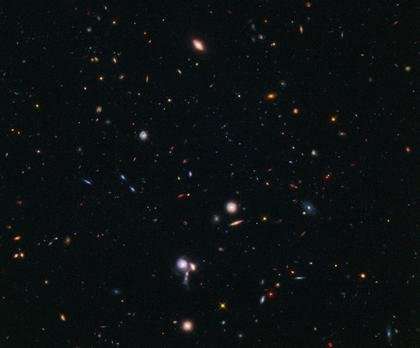International team to use Hubble Space Telescope for early galaxy hunt

(Phys.org) —An international team led by the Kavli Institute for Cosmology at the University of Cambridge and involving the University of Colorado Boulder has a new tool to look for the oldest galaxies in the universe: 32 days of observing time with the Hubble Space Telescope.
The research effort, led by Kavli Institute Fellow Michele Trenti, will involve a meticulous search for the most distant galaxies Hubble can see. The project, known as the Brightest of Reionizing Galaxies Hubble survey, or BoRG, will look for objects whose light started their journey toward Earth when the estimated 13.7 billion-year-old universe was in its infancy—only about 500 million years old, said Trenti.
The effort, which also includes scientists at eight other institutions, will involve 480 orbits of Hubble, or a total of 32 days at 96 minutes per orbit, said CU-Boulder Professor Michael Shull, who currently is serving as a Sackler Distinguished Visitor at the Institute of Astronomy in Cambridge.
"At roughly 500-600 million years after the Big Bang, the BoRG team expects to find roughly two dozen galaxies with a brightness comparable to our own Milky Way," said Trenti, a former CU-Boulder postdoctoral researcher. "But their masses will be tens to hundreds of times smaller because of the higher luminosity of the young hot stars expected in systems that formed when the universe was in its youth."
While previous Hubble observations found just a handful of early galaxies, the search only involved a few pointings in the sky. Although the BoRG survey is expected to acquire images at more than 100 locations in the sky, Hubble's field of view is so tiny the total area covered by the BoRG observations—which will be made in the infrared portion of the electromagnetic spectrum—will only be about seven-tenths of the area of a full moon viewed from Earth.
The BoRG survey is the largest program approved this year by the Hubble Time Allocation Committee. Since Trenti and his colleagues will be making such a huge number of observations, they will be able to share observing time with other Hubble instruments mounted at different positions on the orbiting telescope's focal plane, including efforts to gather the spectra of distant quasars or active galactic nuclei.
"The strategy will make it possible to observe two slightly offset regions of the sky with a camera and a spectrograph at the same time, essentially akin to doubling the efficiency of an already productive telescope," said Trenti.
"The capabilities of the Hubble Space Telescope continue to amaze anyone working with its cameras and spectrographs, " said Shull. "The opportunity to search the cosmos for some of the earliest most distant galaxies is fantastic. It gives us just a taste of what the James Webb Telescope may accomplish at the end of the decade."
Slated for launch in 2018, the massive James Webb Telescope will make infrared observations and is expected to be the world's premier telescope in the coming decade.
The rate of galaxy formation seems to have evolved dramatically at times earlier than 700 million years after the Big Bang, making this epoch a golden age for the formation of the first generations of galaxies, according to the team. Therefore, it is crucial to understand if and how this evolution proceeds by looking back in time.
"We do know this epoch is a time when the early galaxies were forming stars at a rapid rate, and the powerful ultraviolet radiation emanating from them was carving out large cavities throughout intergalactic space," said Shull, a professor at CU-Boulder's Center for Astrophysics and Space Astronomy.
"We are exploring galaxy formation when the Universe was just half a billion years old, and to me it is fascinating to think that the process has been so efficient that galaxies each made of billions of stars were already in place," said Trenti. "But we are not really sure of what we will find by pushing these observations to Hubble's final frontier. The definitive answer will come only after we get the images."
In addition to this high risk-high reward search for the most distant galaxies, the BoRG observations are expected to include a sample of roughly 200 galaxies that formed at 600-900 million years after the Big Bang, or about 13 billion years ago.
Provided by University of Colorado at Boulder




















